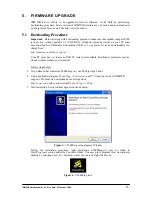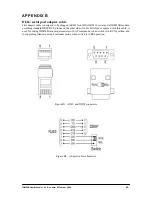
4.4 Test
modes
IDM 50 modem provides on-line test and control functions, such as remote feedback looping
and the transmission of test sequences, thus making possible to measure in-channel signal level
and count bit errors. This possibilities considerably improve commissioning and maintenance
of telecommunications links.
Tests may be initiated when modem is in command mode, by sending test command string
from the PC or terminal. There are 3 types of test commands: INTERNAL, LOCAL and
REMOTE. Generic test command format is
AT&TSTx
, where
x
represent number of test.
Before entering test mode modem return “ENTERING TEST MODE x” where x represents
number of test.
INTERNAL TEST
– Allows validating the correct operation or not of the DSP and Codec
which generates, decodes and processes signals exchanged with the analog line.
AT&TST0
Self
test
– internal test of DSP and Codec. No line signal is generated nor
received during this test. After less than one second modem automatically
return to command mode and returns “OK” message.
LOCAL TESTS
– Enable validation of entire generation, transmission and reception chain of
modem. In this tests modem generate and transmit specific test signal and at the same time
performs receiving function with receive signal level measuring. Measurements are of narrow-
band in-channel type. During tests PWR led blinks fast (100ms / 100ms cycle), DSR and CTS
signals at RS-232 interface are active, DCD led and DCD RS-232 signal indicate receive signal
strength but no RxD signal at RS-232 is received. External loop-back wiring may be attached at
DB15 connector to route transmitted test signal back to receiver. Test 1 use 800Hz test signal
while tests 2, 3, 4 and 5 are performed on pre-programmed TX and RX channels with pre-
assigned TX and RX levels.
Exit from this tests, and return to command mode may be accomplished by sending any
character from terminal or PC to modem. Modem returns values of received level in dB units,
and duration of test in seconds.
AT&TST1
800Hz generation and detection
– generation, transmission and reception
chain with 800Hz test signal.
AT&TST2
Sequence
F-
- generation, transmission and detection of lower frequency of
the channel. Valid only in FSK mode.
AT&TST3
Sequence
F+
- generation, transmission and detection of upper frequency of
the channel. Valid only in FSK mode.
AT&TST4
Sequence
F+/F-
- generation, transmission and detection of both significant
frequencies of channel in alternate and symmetrical sequence. Valid only in
FSK mode.
AT&TST5
Received
Level
- measurement of reception level in dB but without generated
and transmitted signal.
Example:
AT&TST3
ENTER TEST MODE 3
EXIT TEST MODE
TEST STATUS: OK
RX LEVEL: -08dBm
ELAPSED SEC: 00000007
IDM50B User Manual v1.2n, Rev. date: 24 februar, 2009
14









































